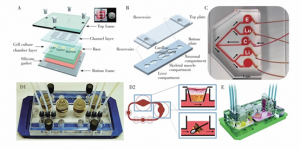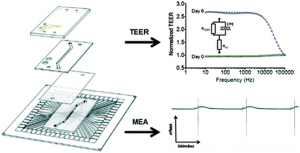Organ chips can flexibly control microfluidics, cells, and their microenvironments through microfluidic chip systems, and build integrated microsystems on microfluidic chips aiming at simulating human tissue and organ functions. Biosafety assessment, as well as biomedical research and testing, provide a screening model that is close to the real physiological and pathological conditions of the human body.

At present, organ chips have been used in drug screening, drug toxicology research, tumor metastasis research, in vivo microenvironment simulation, etc., and are expected to provide a low-cost substitute for animal experiments and early clinical trials in the drug development process. The organ chip can simulate a relatively complex in vivo environment, including the interaction between cells and cells, tissues and tissues, cells/tissues and blood, etc. At the same time, it allows researchers to observe the growth of different cells at different times and spaces, and detect various corresponding indicators.
Detection Technology Based on Organ Chips
Barrier integrity assay
Permeability measurements are an important method for evaluating the integrity of various barriers. By using fluorescently labeled molecular tracers, it is possible to quantify the molecules that penetrate the barrier as well as the permeability of the barrier. Permeability assays typically use small-molecule sucrose, such as sodium fluorescein, or macromolecular polysaccharides, such as fluorescein isothiocyanate-dextran. By using fluorescent tracers with different molecular weights, tight junctions in endothelial cells can be assessed.
Application scope and characteristics:
(1) Fluorescent tracers with different molecular weights can be used as a standard for evaluating the integrity of the organ chip barrier;
(2) Organ-on-a-chip suitable for screening barrier integrity for transport or exposure studies of toxic substances;
(3) Detection of compound-induced barrier damage.
Cell Viability Analysis
Only by realizing accurate real-time monitoring of cellular processes and biomarkers without compromising cell viability can the full potential of organ-on-a-chip technology be realized. Therefore, it is particularly important to develop electrochemical, optical, and immunological detection methods suitable for chips, such as using various sensors and designing more standardized chips to match traditional biological detection methods.
- Electrochemical (TEER) technology
Currently, by integrating multi-electrode arrays (MEAs) and electrodes for transepithelial electrical resistance (TEER) measurement into the chip during organ-on-a-chip fabrication, it is possible to accurately and continuously monitor the “transmembrane resistance value”, thus having multifunctional and real-time sensing capabilities in the detection of cell activity. TEER measurements can be used for ion fluidization between electrodes and across tissue interfaces composed of epithelial and endothelial cells in specific organs. Based on measurements of ion channel restriction or resistance, the functional integrity of these cells can be assessed, as well as the response to damage caused by drugs or other insults.

MEA combined with TEER to measure organ chip cell viability
- High content screening (HCS) technology
High-content screening technology is an activity evaluation method based on the cell level. HCS takes the form of a microplate as an experimental tool carrier, executes the test process through an automated operating system, collects experimental result data with a sensitive and fast detection instrument, and uses a computer to analyze and process the experimental data, which can realize the biological activity of thousands of samples in a short time. The detection technology system can also perform real-time monitoring of live cell responses or kinetic responses for several days. Not only can images of cells be acquired and stored for viewing, but measurements such as cell count, size or shape, translocation, and expression levels can be routinely quantified.
Metabolic Activity Analysis
Metabolic activity analysis based on organ chips refers to the combination of one or several organ chips in a metabolic environment close to that of humans, and the use of polypeptide microbial reactors to measure metabolic activity-related parameters. In addition, different technical means can also be used to compare the results of different levels of metabolic parameters, thereby optimizing its own system and improving the reliability of the analysis. Analysis techniques mainly include:
- Existing detection technology combined with computational simulation analysis for activity determination;
- Integrated quantitative and qualitative analysis of multiple compounds;
- Analysis of physiological interaction between simulated organ tissues in vitro;
- Establish an in vitro drug distribution evaluation model.
Gene Expression Analysis
Gene expression analysis is an important indicator for evaluating the safety of drug candidates. Gene expression generally requires the determination of the cellular abundance of the transcript of a gene in a particular organism. At present, there are many methods for gene expression detection, among which the most common high-throughput detection method is the detection system based on organ chips. Various libraries can be constructed to realize gene expression analysis of various types of samples. Generally speaking, on the gene expression analysis platform, the microarray dot matrix on the fixed carrier will hybridize with the nucleic acid molecules to be tested on the carrier. Then by collecting the fluorescent signal of the sample, the gene expression can be accurately judged.
References:
[1] Maoz, B M; et al. Organs-on-Chips with combined multi-electrode array and transepithelial electrical resistance measurement capabilities. Lab on a Chip. 2017, 17(13): 2294-2302.
[2] Fabian Z; et al. High content screening: seeing is believing. Trends Biotechnol. 2010, 28(5): 237–245.
Related Services:
Microfluidic Chip Development Services for Organ-On-A-Chip
Cell Culture and Organ-On-A-Chip Model Development Services
